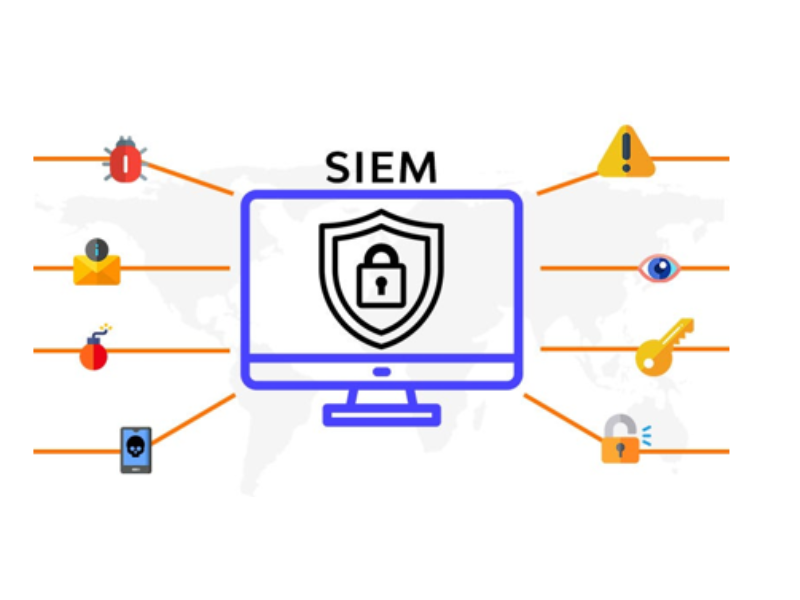Cybersecurity Self-Assessment Resource
Download this resource to measure your appetite for cyber risk and to gauge your current cybersecurity status.

Are you hearing about SIEM tools in conversations regarding CMMC compliance? If so you might be asking the obvious question, “What IS a SIEM tool?” A SIEM Tool is a set of tools and services used for BOTH Security Information and Event Management. These are typically two processes, but a SIEM tool easily combines them.
A SIEM tool provides real-time analysis of Security Events and Logs, such as from your Operating System, applications, networked devices, or system access logs. Almost any log can be ingested by a SIEM tool and used for analysis and alerting.
SIEM tools start with data collection. A SIEM tool can collect logs, events, alerts, and even configuration changes from a variety of sources including network devices, application logs, servers, and other security tools like Firewalls and Antivirus.
After the data is collected, the SIEM tool formats it for easier analysis. This involves tagging items with their source. If forensics become necessary, this process allows for a clear truth.
The tool can then use this data to detect behaviors across the various sources, both good and bad. The term heuristic is often used here. The SIEM can set a profile of “normal and expected” behavior and then use this information to detect what is “abnormal and unexpected.” For example, if the accounting manager logs in at 3am to run commands, that might look a little suspicious.
If the SIEM tool does detect abnormal behavior it can send out alerts quickly. These alerts can be an email, another entry into a piece of security software, or a text to a member of your Network Operations Team. Your organization can customize the process for your needs.
Finally, the SIEM tool provides active visualizations of your network. This can be a dashboard with trends showing where potential and confirmed incidents are or whatever other requirements you define. When an event is categorized, a SIEM then has tools on this dashboard to manage the event, see its impact, and know what linkages exist between systems to help contain the spread of an infection like ransomware.
Like most cybersecurity tools, SIEM tools have pros and cons. Among the benefits are:
Identifying incidents or attacks early. These could be insider threats, persistent threats, and malware infections.
Automating responses to common threats or activities, reducing your response time. Automations can even handle quarantining a device that is believed to be compromised, helping to contain the spread across your network. It can also automatically disable a user account showing suspicious or abnormal activity.
Simplifying the process of meeting statutory, regulatory, and compliance standards, generating reports and logs as required.
Providing a single pane of glass to monitor all security events and incidents across your organization.
While there are numerous benefits to utilizing SIEM tools, there can also be some challenges.
A LOT of data. This data needs to be processed and analyzed efficiently, which means you need some horsepower to do the work.
It can be expensive.
As with any behavior detection, you will have false positives. A false positive means that the conditions were met to alert of a potential incident, but it was actually a legitimate event. This can sometimes overwhelm security teams. This is mitigated over time as machine learning gets dialed in. This is common in companies that operate internationally. If an IT administrator logs in from Asia as well as the United States, that could register as an abnormality in a SIEM tool.
SIEMs are complex by nature. There are a lot of moving parts, and the initial deployment takes time. Understanding your data and normalizing it so the SIEM tool can ingest is probably the biggest hurdle in implementation. With AI and Machine Learning also being adaptive, it takes some time to understand your environment and define normal behavior. There is also added complexity when integrating with other systems in a diverse IT environment, like legacy systems or third-party applications without an API for example.
SIEM tools can require significant resources. It can take a lot of storage and processing power to operate. Some choose to keep this on-premise which incurs hardware costs. Some choose to use the cloud which then can incur cloud hosting costs. You may experience slower performance or delayed reporting as the organization (and its data) grows.
Despite these potential challenges, the benefits of SIEM tools generally outweigh the challenges for many organizations.
A SIEM tool is proactive in that it collects data from various sources. It can ingest logs from your event viewer and custom applications and can also collect and analyze information from data storage locations and database servers. You can set up policies and rules around these various data sources to not only create a profile of what is considered “normal” day-to-day activity but also to alert your Security or Network operations team of any abnormal behavior. These abnormalities could be early detections of a malicious actor or a cybersecurity incident. Because of these capabilities, SIEM tools can assist with compliance to CMMC, ISO 27001, GDPR, and HIPAA controls.
Are you feeling like you are ready for your CMMC assessment or your ISO 27001 audit? Contact us today. As one of the most well-respected C3PAOs (CMMC Third-Party Assessor Organizations) we can talk about your cybersecurity environment and can schedule your assessment.